Is Radio-frequency identification (RFID) technology a groundless expense or the solution to all your supply chain management problems? RFID technology offers new possibilities as it solves some of the biggest problems in supply chain management. Some of them are analyzing and collecting large sums of data, low labour costs and operational costs, and more.
RFID tech is a costly investment, and although the cost has come down over the past couple of decades, it’s still essential to assess precisely how RFID can deliver value for your buck. Before using RFID technology, businesses should access their budget, goals and priorities. RFID is pretty great as it has the potential to transform your business, but it all comes at a cost.
A Rundown of RFID Technology
RFID uses radiofrequency waves to transfer data without contact, i.e. wirelessly. A barcode represents information in a set of black and white lines. When scanned, a barcode allows computers to understand the difference between a box of cake mix and a brownie mix box.
A barcode functions differently from RFID scanners because they need a line of sight to the barcodes. RFID scanners communicate with the RFID tags on items without seeing them. RFID techs alone is a mouthwatering proposition; imagine slashing the inventory time by checking every box without opening them. An RFID tag ensures a manufacturer can track every single part and providing visibility over every moving part in the supply chain.
Wells Fargo data centers, for instance, uses RFID scanners in laptops to track whether a computer is leaving with its rightful owner, preventing data breaches and thefts. In other words, RFID, with its abundance of uses, helps companies maintain control in a formless, fast-moving world.
How Businesses Incorporate RFID Into The Supply Chain
The supply chain consists of four elements such as integrations, operations, purchasing and distribution, each of which presents an opportunity to leverage RFID technology.
Integration: Key elements to a successful supply chain include good integration, communication and information sharing. Imagine running a restaurant where you have to fill out four forms to submit an order. It makes no sense, right? With RFID technology, placing an order can happen in a jiff. RFID makes it easier to share information between suppliers, warehouses, and transportation companies. In other words, a tighter supply chain is a more robust supply chain.
Operations: RFID help companies track goods as they move through their warehouses. Inventory management becomes more efficient since companies have real-time information about the goods in transit, the warehouse, and what’s been sent to customers. In the future, RFID integrations will be capturing data from a few centimetres of a warehouse with the help of RFID scanner drones.
Purchasing: Purchasing is such an essential part of the supply chain process. Whether you’re making clothes or computers, you need specific pieces to create the final product. Suppliers who have RFID technology provide real-time visibility over in-stock raw materials and semi-finished materials. It allows you to verify everything you’ve ordered is in a given shipment. It minimizes the time and moves items to the production stage sooner.
If you and your supplier use RFID technology, your goods and customers are protected, and your company’s compensation from that supplier is sped up as well.
Distribution: Logistics refers to the coordination and movement of goods from point A to point B. Good logistics make distribution possible, whether distributing raw supplies to manufacturers, distributing finished goods to warehouses, or distributing individual items to consumers. It is critical to maintaining quality control as the perishable items can get ruined. Thus, it’s essential to know your goods’ status. Access to real-time data allows you to make quick decisions about a shipment crossing from point A to Point B.
Cost of RFID Tags
The expense of your RFID system depends on the type of RFID tags you choose. RFID tags come in two categories, active RFID tags and passive RFID tags. Active ones have their power source, for example, a battery, and can transmit a signal. And the passive ones don’t have their power source; they receive power from the RFID reader. There are also different types of RFID tags with numerous capabilities within each category, determining each tag’s cost. Remember that a pricier RFID tag may be expensive as it provides a good return on investment, depending on your business.
Drawbacks of RFID Technology
Security concerns: A chip must have appropriate authentication features; otherwise, an employee could change the item’s price to using the chip’s read and write capabilities.
Privacy concerns: RFID technology can track customers’ data to understand their shopping behaviour.
High upfront costs: Although the cost of RFID technology has come down over the years, some RFID techs are highly expensive in addition to the cost of the tags.
